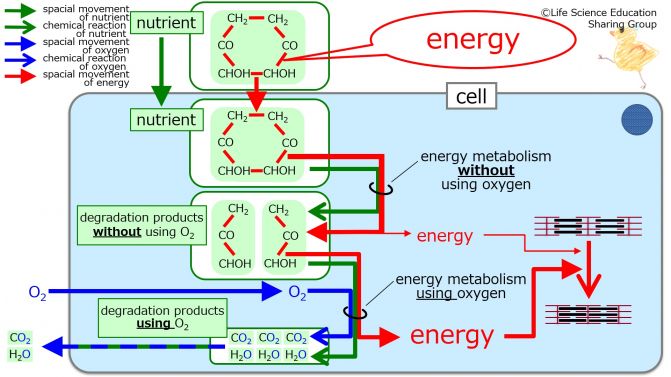「EnergyMetabolism/NutrientAndEnergyy/BasicSummary」の版間の差分
編集の要約なし |
編集の要約なし |
||
| (同じ利用者による、間の7版が非表示) | |||
| 1行目: | 1行目: | ||
[[メディア:4728.mp4|動画と音声での説明]] | |||
[[ファイル:04730-Eng.jpg|left|671px]] | |||
<br style="clear:both;" /> | |||
In summary, initially in energy metabolism, oxygen is not used and a small amount of energy is removed from the nutrient. Next, oxygen is used and a large amount of energy is removed. The nutrient loses chemical energy which had connected atoms into one molecule, and is broken down to many small degradation products such as carbon | Nutrients have chemical energy, connecting atoms into one molecule. When a nutrient enters a cell, so does its chemical energy. The cell removes the chemical energy (connection) from the nutrient. This breaks down the nutrient, which becomes a degradation product. Cell activity, such as muscle contraction, consumes the removed energy. This is the overview of energy metabolism. | ||
In the initial step of energy metabolism, oxygen(O<sub>2</sub>)is NOT used. Amount of energy removed from the nutrient is small, and a large amount of energy remains in the degradation product. | |||
Oxygen also enters the cell, and in the next step of energy metabolism, oxygen IS used. A larger amount of energy (connection) is removed, and the “degradation products without using oxygen” is further broken down into many smaller degradation products such as carbon dioxide(CO<sub>2</sub>) and water(H<sub>2</sub>O). Naturally, cell activity can also use such energy. | |||
In summary, initially in energy metabolism, oxygen is not used and a small amount of energy is removed from the nutrient. Next, oxygen is used and a large amount of energy is removed. The nutrient loses chemical energy which had connected atoms into one molecule, and is broken down to many small degradation products such as carbon dioxide(CO<sub>2</sub>)and water(H<sub>2</sub>O). The degradation products exit the cell. | |||
2023年6月9日 (金) 12:05時点における最新版
Nutrients have chemical energy, connecting atoms into one molecule. When a nutrient enters a cell, so does its chemical energy. The cell removes the chemical energy (connection) from the nutrient. This breaks down the nutrient, which becomes a degradation product. Cell activity, such as muscle contraction, consumes the removed energy. This is the overview of energy metabolism.
In the initial step of energy metabolism, oxygen(O2)is NOT used. Amount of energy removed from the nutrient is small, and a large amount of energy remains in the degradation product.
Oxygen also enters the cell, and in the next step of energy metabolism, oxygen IS used. A larger amount of energy (connection) is removed, and the “degradation products without using oxygen” is further broken down into many smaller degradation products such as carbon dioxide(CO2) and water(H2O). Naturally, cell activity can also use such energy.
In summary, initially in energy metabolism, oxygen is not used and a small amount of energy is removed from the nutrient. Next, oxygen is used and a large amount of energy is removed. The nutrient loses chemical energy which had connected atoms into one molecule, and is broken down to many small degradation products such as carbon dioxide(CO2)and water(H2O). The degradation products exit the cell.
